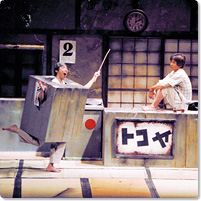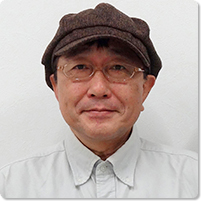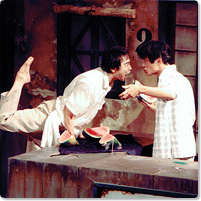
Data :
Premiere: 1995
Length: 1 hr. 35 min.
Acts, scenes: one act and six scenes
Cast: 2 (men)
Kudan no Ken

Born 1960 in Ichinomiya city, Aichi Prefecture. Amano is the leader, playwight and director of the theater company Shonen-oja-kan. After a period with the theater company Benijujisha, he started the company Gekidan Shonen-oja in 1982 (name changed to Shonen-oja-kan in 1985). With Amano as the writer and director of most of the works this Nagoya-based company performs nationwide in Japan. In 1992, he drew attention from various directions with his adaptation of Tatsuhiko Shibusawa’s Takaoka Shinnou Kokaiki for outdoor theater. In 1994, Amano directed his first short film Twilights which won the Grand Prize at two international film festivals (Germany’s 41st International Short Film Festival Oberhausen and Australia’s 44th Melbourne International Film Festival Short Film Division). Since 1998, Amano has directed for the KUDAN Project and simultaeously began giving overseas performances. In 2000, his play OSHIMAI – Kudan no Ken was nominated as a finalist for the 44th Kishida Drama Awards. In 2005, Amano drew attention with his production Hyakunin Shibai – Mayonaka no Yaji-san, Kita-san with more than 160 actors participating. Amano’s diverse artistic activities also include writing and directing for companies including Ryuzanji Company, ITO Project, Amagasaya and others. In May 2019, Amano will write and direct a new work titled “1001” at the New National Theatre, Tokyo.
Shonen-oja-kan
http://www.oujakan.jp/


One summer’s day, at no particular time, in no particular place… Hitoshi is behind a shabby old counter when Taro comes in. Having once lived in the area, Taro has returned to enquire after a stray kudan that he had kept in an upstairs room of his row house.
The pair amuse themselves chewing gum, exchanging cups of barley tea, playing at being barbers or pretending to be in a time machine, and so forth, with their antics becoming increasingly frenzied. This unremitting and deeply unsettling spectacle is rather like seeing the two of them in a dream in which each is seeing the other in a dream.
When they talk nostalgically about a “true summer” that they once shared, we begin to realize that they were apparently childhood friends. Taro opens up his cloth bundle to reveal a bright red watermelon and, as they eat the fruit, they recall one July 7 when they had still been friends. This is the night of the Tanabata, or Star Festival, when people typically write a wish on a strip of paper that is then hung from bamboo. Hitoshi’s wish had apparently revealed his eschatological tendencies, while Taro’s wish had put a curse on Hitoshi. It thus seems that their relationship had been one of ruler and subject.
Before long, the bright red watermelon comes to be associated with a freshly severed head covered in blood, the phrase “squash a mosquito” (
ka o tsubusu
) becomes “squash a face” (
kao o tsubusu
) and the “cow upstairs” (
nikai no ushi
) is transformed into “brain dead upstairs” (
nikai nou shi
). The allusion is that when they were children, Hitoshi had somehow been pushed down the stairs by Taro and split open his head, and even now remains in a persistent vegetative state. Taro has kept this traumatic memory suppressed, but it is now revived.
The stage revolves to show a rural-style upstairs tatami room. Hitoshi is taking care for Taro, who has just recovered from sunstroke. Perhaps that room is Hitoshi’s, as he awakens from his thirty-five-year coma… Perhaps it was all Taro’s dream… The play ends abruptly as Hitoshi mutters that he’d woken up only to find that there was nothing left in the world. Everything is removed to leave, but only the home-delivered pizza just arrived in the real world is left on the bare stage.
Related Tags